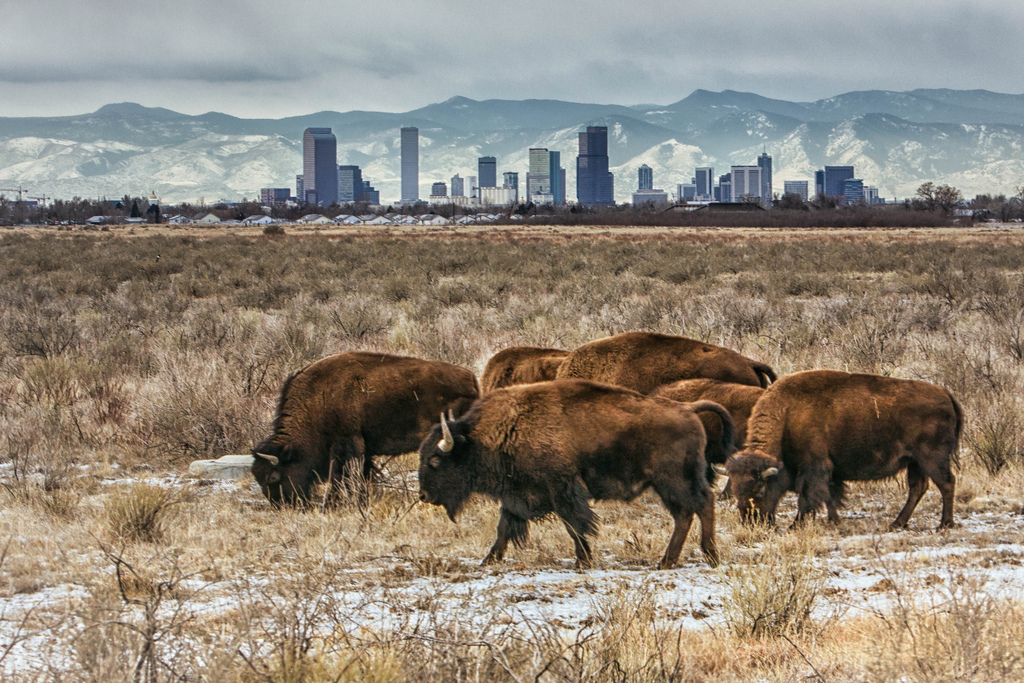What makes a wildlife refuge special?
Is it the ability to protect ecosystems and endangered species? Is it the protection of open space for recreational uses, like fishing and hiking? Is it the thought of keeping wilderness safe for future generations? How do the explosives fit in?
This is a very real question, and one that’s becoming increasingly relevant as the United States retires and reassigns the millions of acres of military land it acquired in the years surrounding World War II and the Cold War. In Indiana, the military history of Big Oaks National Wildlife Refuge is written in the 7 million inert projectiles with live fuses, 1.5 million rounds of unexploded ordnance, and 75,000 kilograms of depleted uranium remaining at the site. In Colorado, prairie species like the American bison are slowly returning after a multi-billion dollar remediation of contaminated soil and groundwater at the former Rocky Mountain Arsenal near Denver. Sites like these can be important to conservation efforts, but behind new visitor-friendly goals belie complex histories that can’t be ignored, as David Havlick discusses in his 2014 paper “Opportunistic Conservation at Former Military Sites in the United States”.
Reusing military land for public use isn’t a new idea, but Havelick may be the first to comprehensively discuss the challenges faced by wildlife refuges struggling to contend with their military past, and the opportunities they offer for conservation.
Military to wildlife refuge conversion (sometimes abbreviated as M2W) can, in theory, work well both for the American people and the Department of Defense: since the military is responsible for paying for and carrying out remediation of retired bases, it’s far better for them to find a use that allows them to avoid the painful process of combing the entire base for hazards in preparation for construction. Instead, officials can focus on the areas where the contamination poses a risk to the public, and leave the rest as it is. Once these sites have been remediated, they’re usually turned over to the Fish and Wildlife Service for management. The United States has closed or reassessed over 400 military operations in the past quarter century, and EPA projections indicate that an attempt to fully remediate all 16,000 contaminated military sites in the country would constitute the largest remediation project in the U.S. government’s history. With M2W, the military offloads unwanted land while limiting expenditures, simultaneously providing open space for the public and supporting local ecosystems.
The sites’ military history doesn’t disappear when they’re declared wildlife refuges. At Big Oaks, rolling grasslands cleared by decades of munitions testing now support native birds and reptiles found nowhere else in the state. To maintain these grasslands, refuge workers conduct regular prescribed burns to decrease the risk of catastrophic wildfires. Because of the site’s history, however, conventional burn methods were deemed too dangerous given the presence of undetonated bombs, shells, and grenades. Instead, refuge workers experimented with ignition by remote-control helicopter rather than using human pilots. In the case of an accidental detonation, at least no human would be harmed.
Paradoxically, the presence of these dangers can protect wildlife; one refuge official pointed out that “From an enforcement and public education standpoint, it’s much easier to keep people out of refuges when there’s a public safety concern, such as UXO [unexploded ordnance] than for biological reasons.”
Environmental accountability in the military is a relatively new concept. With few notable exceptions, awareness of how domestic military activities affect the environment really only began to develop in the 1960s and 70s, well within the lifetimes of many people alive today. For this reason, the actions taken at these sites establish an important precedent for how we deal with contaminated military areas in the future. Military to wildlife refuge conversion, if approached with the right intentions, can save deeply contaminated land. If approached with the wrong intentions, it can provide an environmental smokescreen that masks a history of military negligence. War has changed a lot in the past fifty years, but we’re still living with the environmental consequences of previous generations’ choices. We have the chance to revisit those choices and at least try to make them right, by engaging with these sites’ military histories rather than obscuring them. If we don’t, future generations will suffer for it.
